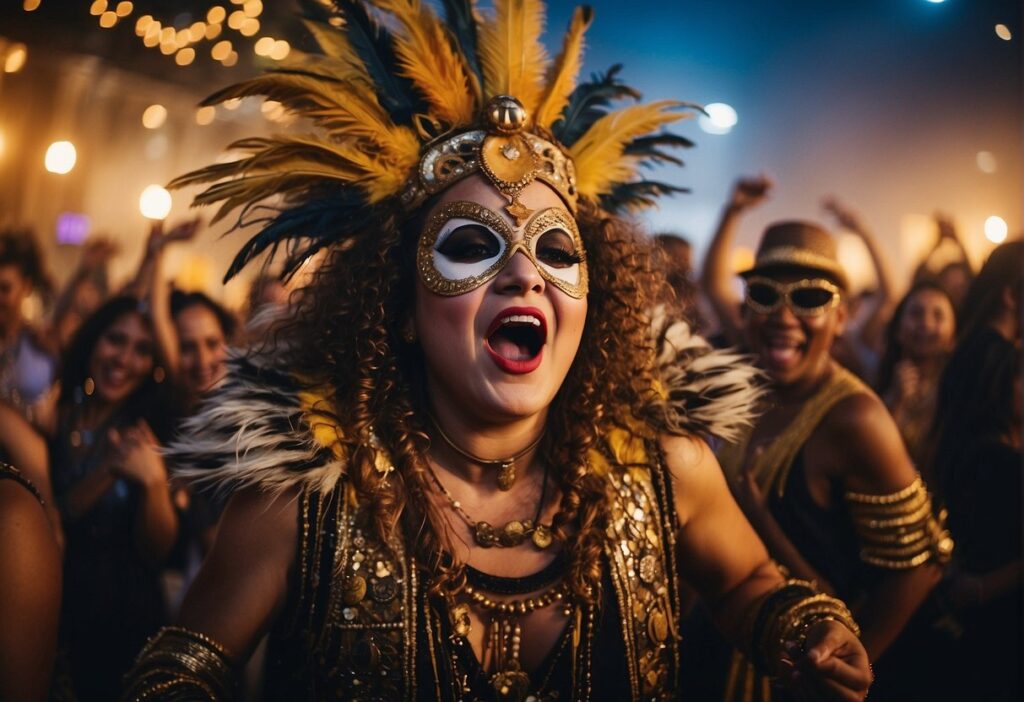Bacchanalia, originating from ancient Rome, centered on Bacchus, the god of wine, freedom, and ecstasy. These festivities were infamously shrouded in mystery, often perceived as a symbolic departure from societal norms and an invitation to indulge in unfettered pleasure.
Despite their notoriety, the bacchanalia played a significant role in the cultural and spiritual life of Romans, reflecting deep-rooted traditions that have intrigued scholars for centuries.

Tracing back to the Greek Dionysia from which they were derived, these rituals made their way into Roman society through Greek colonies and neighboring Etruria around 200 BC.
Characterized by exuberant feasts and performances, the bacchanalia were dynamic gatherings that could involve drama, music, and revelry. While often condemned for their perceived excesses, the celebrations were an integral part of the communal experience, with their symbolism resonating with societal and psychological themes relevant even in modern times.
Key Takeaways
- Bacchanalia were rooted in Roman traditions and symbolized freedom and pleasure.
- They evolved from Greek Dionysian rites and formed an important communal ritual in Ancient Rome.
- The celebrations have historical and cultural significance, sparking scholarly interest through time.
Historical Context
Discover the vibrant tapestry of Bacchanalia that unfurled across Ancient Rome. Unveil the deeper nuances of how this mystery cult carved its place within Roman religion, and the intersecting paths it shared with Greek culture.
Bacchanalia in Ancient Rome
Bacchanalia were ecstatic festivals held in honor of the god Bacchus, akin to Dionysus of Greek mythology, god of wine and festivity. These rites were known for their uninhibited revelry, a stark contrast to the typically structured Roman public religious practices. As a result, they attracted the scrutiny of the Roman Senate.
In 186 BC, concerns over the cult’s influence led to the issuing of the Senatus Consultum de Bacchanalibus, a decree that severely restricted Bacchanalia and aimed to curtail its perceived threat to Rome’s social and moral fabric.
Origins and Development
The inception of Bacchanalia can be traced back to the mysteries surrounding Dionysos, a deity whose worship involved secretive rituals.
Bacchanalia evolved from the Greek Dionysia, a festival characterized by passion plays such as Euripides’ “The Bacchae”, which heralded the god’s mythology. Initially, the ceremonies involved simpler forms of worship, but over time they grew in complexity and scale, mirroring the flamboyant spirit of their patrons.
Cross-Cultural Influences
Bacchanalia demonstrate the blending of Greek origins and religious practices with Roman religion. The diffusion of these rituals from Greece into Rome likely occurred through Greek colonies in Southern Italy and contact with Etruria.
The cult’s popularity can be seen as a testament to the reach of Greco-Roman religion and its open acceptance of deities like Isis, pointing to a larger pattern of religious syncretism across the Mediterranean.
The Rituals and Celebrations

In the ancient Roman Empire, you would find that the Bacchanalia held a particular allure, with their vibrant and sometimes controversial rituals making a significant impact on society.
Ritual Practices
During Bacchanalia, men and women would converge in secret to participate in rites heavily infused with symbols of wine and fertility god Dionysus.
The festival included the use of ivy, vine, and cymbals, and participants often carried a thyrsus—a staff wrapped in ivy and vine leaves, topped with a pinecone.
It was believed that these practices connected attendants with the divine; wine, as a key element, symbolized the god’s blood, encouraging a loss of societal inhibition and an embrace of primal freedom.
The ceremonies were nocturnal and linked to the Dionysian Mysteries, involving dances, ecstatic music, and fire, with reports of serpent handling.
Maenads or Bacchae—the female followers of Dionysus—and sometimes men, would enter states of ritual madness, consumed by the energy of their god.
Societal Participation
Originally, the Bacchanalia were a festival for women only that occurred three times a year. However, over time, men began to participate, and the frequency of the celebrations increased to five times a month.
The festival became a melting pot, welcoming individuals across different classes, including freeborn Romans.
What started with women’s rites to connect with the earth and divine, expanded to become a societal phenomenon, rich in wine, orgies, and shared ecstasy.
Changes and Legal Actions
In response to the Bacchanalia becoming a perceived threat to the Roman state due to their secrecy and disregard for societal norms, the Roman Senate intervened.
In 186 B.C., the senatus consultum de Bacchanalibus (senate decree concerning the Bacchanalia) was enacted, which resulted in a strict regulation, specifically targeting the festival’s orgies and lack of public transparency.
Postumius, the consul who uncovered the supposed threats, pushed for legislation that greatly reduced the size of the gatherings, and prescribed severe penalties, including the death penalty, for those who didn’t comply.
There were exceptions made for special cases where the rites could be performed without legal repercussions, but only if explicit permission was obtained from the Senate.
The paculla annia case led to the prohibition of women’s involvement in the festival, confining its rites to men.
Over time, what was once an extravagant ritual held on the Aventine Hill epitomizing freedom, became a closely monitored event within Roman civil structure, carefully watched to prevent the re-emergence of what the Roman festivals had once been.
Symbolism and Significance
The Bacchanalia rituals were deeply symbolic events offering insights into ancient practices of mystery religions and the thematic presence of ecstasy, rebirth, and freedom within a religious context.
Religious Significance
The Bacchanalia were rooted in the mysteries surrounding Dionysus (or Dionysos), the god of wine, ecstasy, and rebirth.
Your participation in these rituals connected you to the divine narrative of Dionysus, embodying his life cycle of death and rebirth, an experience aimed at granting spiritual renewal.
Adherents believed they could achieve a form of ecstasy, where they would ‘step outside’ themselves, allowing the soul to commune with Dionysus, often referred to as Eleutherios, meaning the liberator.
The Thyrsus, a staff entwined with ivy and vines, became a symbolic item carried during festivities, representing the prosperity and bounty Dionysus provided.
Social Implications
Socially, Bacchanalia allowed you, regardless of status, to experience a level of freedom not found in the structured civic life.
These secretive gatherings, often associated with Rome’s native cult of Liber, stood apart from traditional Roman religious practice, offering an escape, a secret sanctuary of indulgence.
The Mystery Cults underscored this allure of secrecy, where practices known only to initiates hinted at deeper truths.
Associations with groups like the Maenads, female followers of Dionysus known for their wild and frenzied states, as well as the Bacchae, reinforced the idea that the Bacchanalia were transformative events reshaping not just individual spirituality but also communal bonds through shared, profound experiences.
Historiography and Literary References

Historiography and literary references of the Bacchanalia provide deep insight into the cultural and social dynamics of ancient Rome and Greece. You’ll find evidence of Roman attitudes toward the exotic and the licentious as well as artistic expressions spanning from antiquity to the modern era.
Livy’s Account
Livy, a prominent Roman historian, depicted the Bacchanalia as a hotbed for Roman degeneracy.
He detailed a conspiracy of women who led these rites, suggesting moral decay within the Roman Republic.
His accounts have been critical in understanding both the Roman perspective on the ceremonies and the underlying fears of foreign influence and moral corruption. The narrative provided by Livy becomes a focal point for later interpretations and the anthropology of ancient Roman religion.
Dionysian Art and Literature
Your appreciation of the Bacchanalia cannot be complete without acknowledging its influence on art and literature.
These rituals inspired Euripides’ “The Bacchae”, a play where the god Dionysus takes vengeance on a disrespectful mortal king. This important work captures the ecstatic and terrifying aspects of the Dionysian rites.
Additionally, numerous paintings and dramatic performances have emerged across cultures, glorifying or vilifying the Bacchanalia’s overtones of frenzy and liberation.
These visual and literary portrayals echo the festivities, especially those held at the Theatre of Dionysus in Athens.
Modern Interpretations
Modern interpretations of the Bacchanalia have been shaped significantly by anthropological studies and contemporary thought.
Today, you might find parallels drawn between ancient Dionysian experiences and modern festivals. These explore themes of catharsis, community, and individuality.
Whether the focus is on the liberating or the chaotic elements of the Bacchanalia, these contemporary views often reflect larger societal interpretations of hedonism and constraint.

